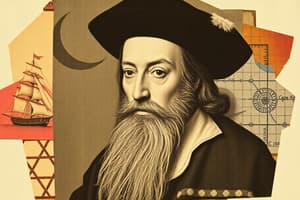Podcast
Questions and Answers
Nochebuena is a Catholic holiday celebrated in the Philippines.
Nochebuena is a Catholic holiday celebrated in the Philippines.
True (A)
What does the term 'Mestizo' refer to in the context of the Spanish era in the Philippines?
What does the term 'Mestizo' refer to in the context of the Spanish era in the Philippines?
Filipinos who are mixed with other blood.
Which of the following is a typical dish associated with Spanish contributions to Philippine cuisine?
Which of the following is a typical dish associated with Spanish contributions to Philippine cuisine?
- Sushi
- Tacos
- Chow Mein
- Sinigang (correct)
The Filipino word for the traditional practice of greeting elders by taking their hand and placing it on one's forehead is called __________.
The Filipino word for the traditional practice of greeting elders by taking their hand and placing it on one's forehead is called __________.
Match the following social classes from the Spanish era in the Philippines with their descriptions:
Match the following social classes from the Spanish era in the Philippines with their descriptions:
What was one of the main reasons for the Spanish expedition led by Magellan?
What was one of the main reasons for the Spanish expedition led by Magellan?
The expedition led by Magellan was primarily motivated by the search for gold.
The expedition led by Magellan was primarily motivated by the search for gold.
What did Magellan's expedition discover in October 1520?
What did Magellan's expedition discover in October 1520?
Magellan and his crew first landed in the island of _____ at the entrance of the Gulf of Leyte.
Magellan and his crew first landed in the island of _____ at the entrance of the Gulf of Leyte.
Match the following events with their corresponding dates:
Match the following events with their corresponding dates:
Which ship was NOT part of Magellan's expedition?
Which ship was NOT part of Magellan's expedition?
What was the significance of the blood compact made in Limasawa?
What was the significance of the blood compact made in Limasawa?
Lapu-lapu willingly accepted the sovereignty of Spain.
Lapu-lapu willingly accepted the sovereignty of Spain.
Flashcards are hidden until you start studying
Study Notes
Circumnavigation and Magellan's Expedition
- Circumnavigation refers to traveling all the way around an object, specifically noted in the context of global sea travel.
- Ferdinand Magellan, a Portuguese explorer, led the first expedition to circumnavigate the globe.
Reasons for the Spanish Expedition
- Objectives included finding the Spice Islands, spreading Christianity, and enhancing Spain's fame and glory.
- King Charles I of Spain sanctioned the expedition, providing five ships: Trinidad, Concepcion, San Antonio, Victoria, and Santiago, along with food and navigational tools for a two-year journey.
Key Events of the Journey
- Departure: The expedition set sail on September 20, 1519, from San Lucas, Spain.
- Discovery: On October 21, 1520, Magellan found a southern strait, now known as the Strait of Magellan.
- Landfall: On March 17, 1521, they landed at Homonhon Island, naming it "The Archipelago of Saint Lazarus."
- March 25, 1521: A blood compact was established between Rajah Kulambu and Rajah Siagu.
- March 31, 1521: The first Christian mass in the Philippines took place at Limasawa, officiated by Father Pedro de Valderamma.
- Conversion Efforts: In April 1521, Magellan arrived in Cebu and aimed to convert the local population to Catholicism.
Conflict and Death of Magellan
- Lapu-lapu, a local chieftain from Mactan, opposed Spanish presence, leading to the Battle of Mactan on April 28, 1521.
- Magellan was killed in this battle, marking significant resistance against Spanish colonization.
Spanish Colonial Rule in the Philippines
- After Magellan's death, Miguel Lopez de Legazpi and Spanish forces established colonial rule in the Philippines, lasting for 333 years.
Motives for Spanish Conquest in the Philippines
- Main motivations categorized as God (religion), Gold (resources), and Glory (national pride).
Spanish Contributions to Filipino Culture
- Religious Practices: Establishment of altars in homes with Catholic imagery; observance of Roman Catholic holidays such as Christmas, New Year, Semana Santa, and All Saints' Day.
Spanish Cuisine Influences
- Notable food contributions include Lechon, Puchero, Paella, Embutido, Leche Flan, Kare-kare, Sinigang, and Lumpia.
Cultural Practices and Values
- Introduction of customs: "Pagmamano," Siesta, "Mañana Habit," Simbang Gabi, and various prayer practices.
- Established social norms and leisure activities such as cockfighting.
Educational Contributions
- Introduction of Western education systems, incorporating subjects such as Spanish history, language, arithmetic, and music.
Social Class Structure During Spanish Era
- Peninsulares: Spaniards born in Spain.
- Insulares: Spaniards born in the Philippines, often holding key positions in government.
- Mestizos: Individuals with mixed ancestry, including Mestizo de Español (Spanish and Filipino mix) and Mestizo de Sangley (Chinese and Filipino mix).
- Tornatras: A term used for individuals of mixed heritage.
- Indios: Indigenous Filipinos with Austronesian lineage.
Studying That Suits You
Use AI to generate personalized quizzes and flashcards to suit your learning preferences.




